KANNADA WEDDING: RITUALS, CEREMONIES, ATTIRE & MORE!
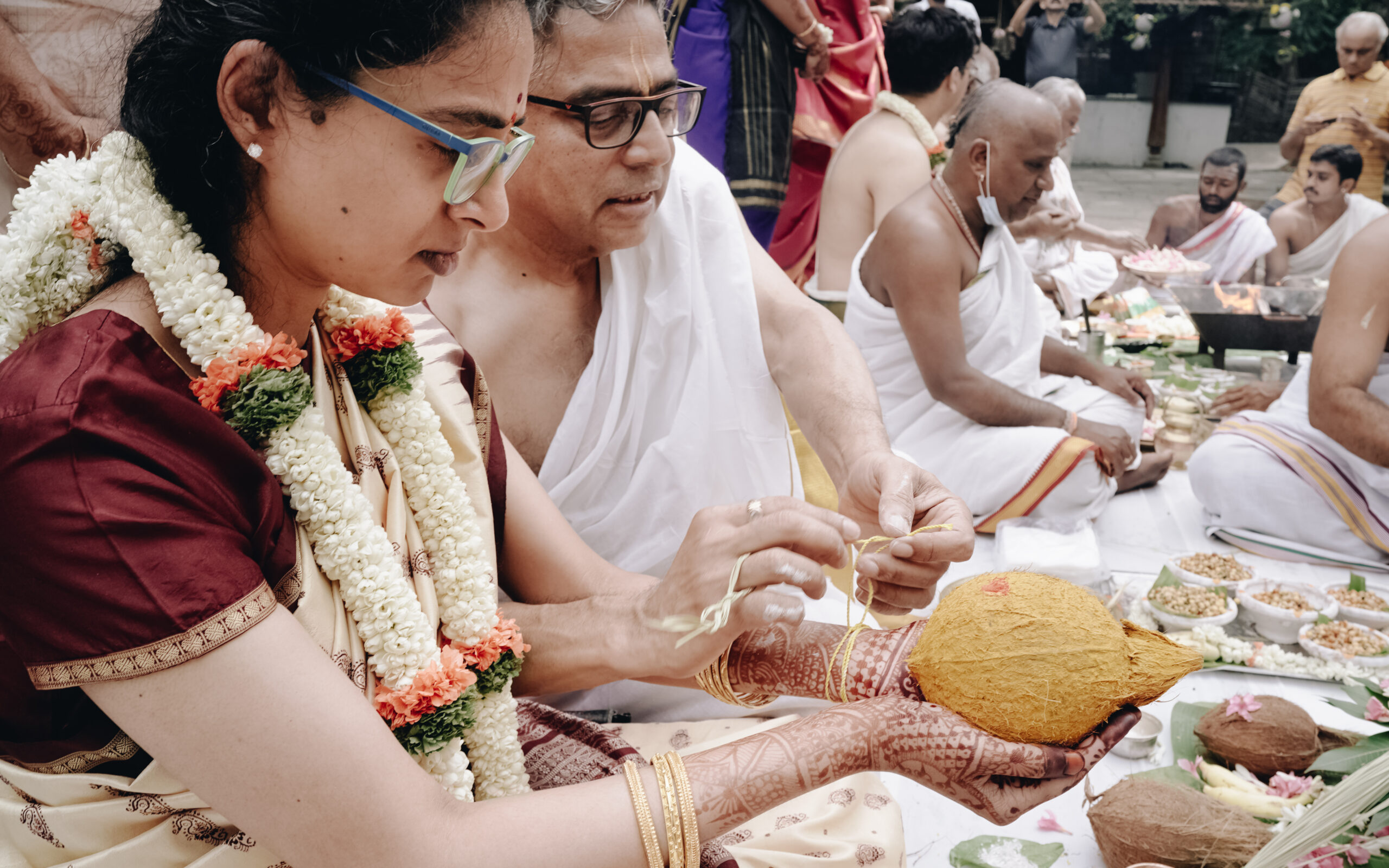
Welcome to a Kannada wedding, where the magic of Karnataka comes to life. In this special journey, two people are about to join their lives together, surrounded by the warmth of customs and the joy of family and friends. Let’s dive into the beauty of a Kannada wedding, where old traditions meet new beginnings!
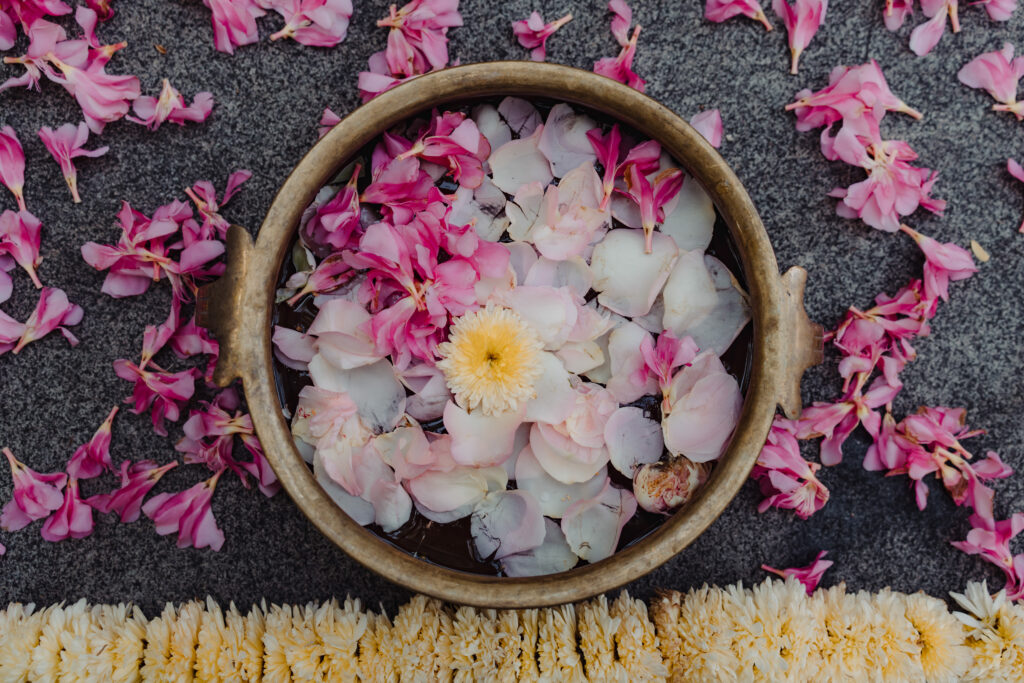
Groom’s attire
In a traditional Kannada wedding, the bride and groom’s attire is a harmonious blend of cultural richness and elegance. The groom typically wears a traditional outfit comprising a white or cream-colored dhoti known as Panche and a silk angavastram draped over his shoulders. This is often accompanied by a stylish shirt or kurta. The groom’s head is adorned with a headpiece called Mysore Peta.
Bride’s attire
A typical Kannada bride dons a resplendent Kanjeevaram silk saree, often in vibrant hues, intricately woven with captivating designs. Traditionally the colours are off-white and red, but more varied colours are being seen on brides these days. The six yard saree is draped in the traditional manner, and her hair is adorned with a long braid with a kucchu(ornaments on the braided hair) and lots of fresh flowers and jewellery.
Pre-wedding ceremonies
Nishchitarta/Nischay Tamulam
The festivities begin with Nishchitarta/Nischay Tamulam, an official engagement ceremony, where the couple exchange bands typically made out of gold, carefully selected for each other, symbolizing their bond, promising to experience life with the other. The parents of the couple also exchange Tambula, which consists of fruits, coconut, betel leaves and betel nuts, symolising the commitment that the families make to one another.
The ceremony is also graced with gifts given to the bride by the Groom’s parents and vice versa. This ceremony serves as an occasion for blessings and approval from both families to kick off the festivities with a bang!
Naandi
The Naandi ceremony that succeeds is usually held at the respective residences. A copper vessel filled with holy water, symbolizing amrit and reminiscent of divine nectar, becomes the centerpiece of the ceremony. It’s a ceremony mainly used to seek blessings from the almighty, praying for all the festivities to go as planned. Naandi represents four main values that every human being stands by – truth, righteousness, peace, and love. Offering prayers to the deity gives way to goodness flowing into the couple’s life. In some households, this ceremony is performed at the start of the wedding festivities to invoke ancestral blessings.
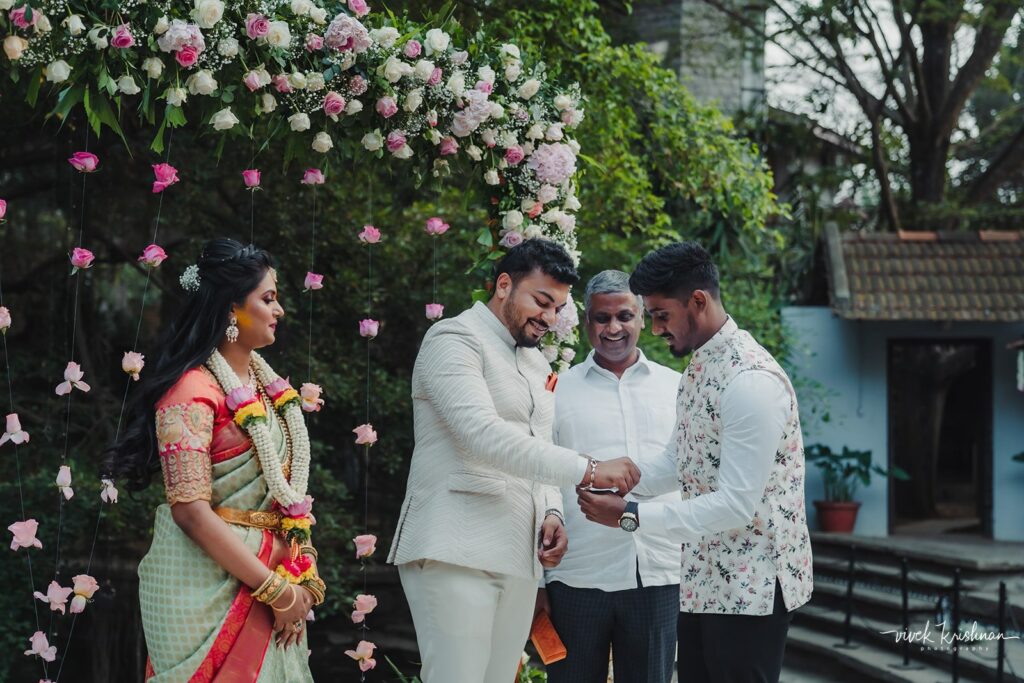
Chapra Pooja
Following this, the chapra pooja is performed to mark the beginning of an auspicious event. It’s a structure made of coconut leaves right outside the house’s entrance. The word ‘Chapra’ in the ‘Chapra Puje’ in a Kannada wedding, refers to a type of grass used. “Chapra Puje” is a ritual where the bride and groom offer prayers to the Goddess Gowri (Goddess Parvati) using bunches of chapra grass that is intertwined to make a shaded structure built outside the house that lets everyone in the community know that there is a wedding in the house. The use of chapra grass in the ceremony carries symbolic importance in Kannada weddings, representing purity, fertility, and prosperity.
Bale Shaastra
Bale Shaastra is a small pre-wedding ceremony for the inner circle and close family, which is done to distribute bangles amongst married women of the family by the bride. Bangles, beyond their role as a fashionable accessory for women, hold symbolic significance associated with health, luck, and prosperity. The colors of these ornaments also carry symbolic meanings, with red symbolizing energy and abundance, and green symbolizing good fortune and fertility. Additionally, women often visit a temple to seek blessings from the divine.
Arshina Shastra (Haldi)
This is a fun ceremony that happens in the respective homes of the couple. In recent times, families have chosen to do the event together as it adds to the festivities. Turmeric or Haldi paste is applied to both the bride and groom by all members of the family. In olden days, this used to help keep the couple free from any bacteria or virus and also helped to add a glow to the skin! Some families perform this ritual the night before the wedding as well and some families do 3 rounds of this ritual throughout the festivities. After the paste has been smeared on the couples faces and bodies, haldi snana is performed which is bathing the couple in turmeric water. More often than not, this ritual turns into a fun game of laughter and water splashes.
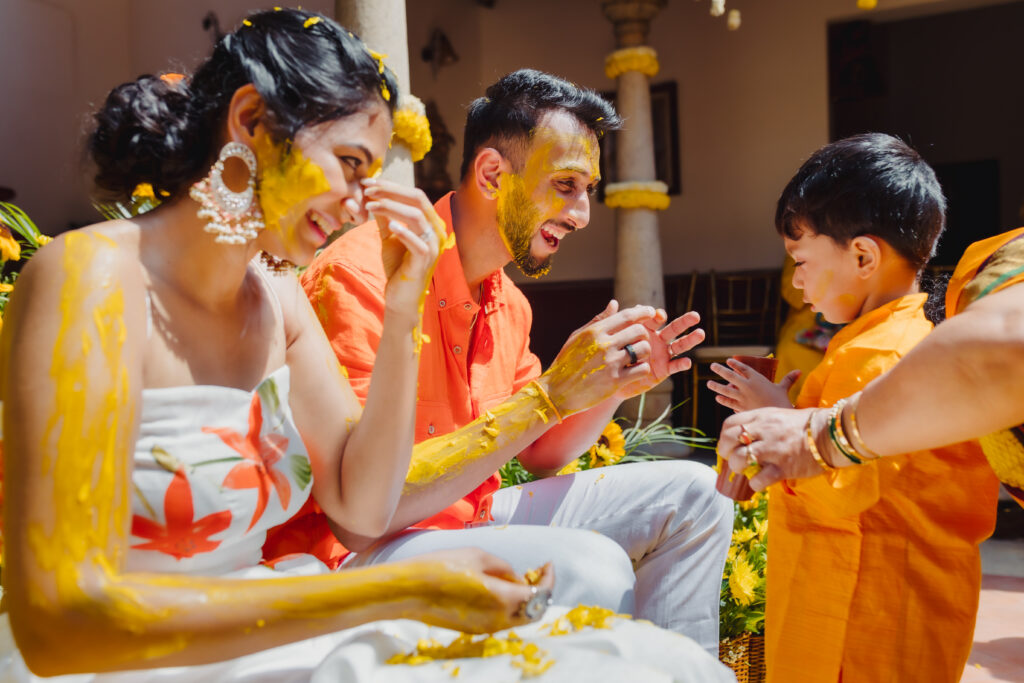
Vara Pooja
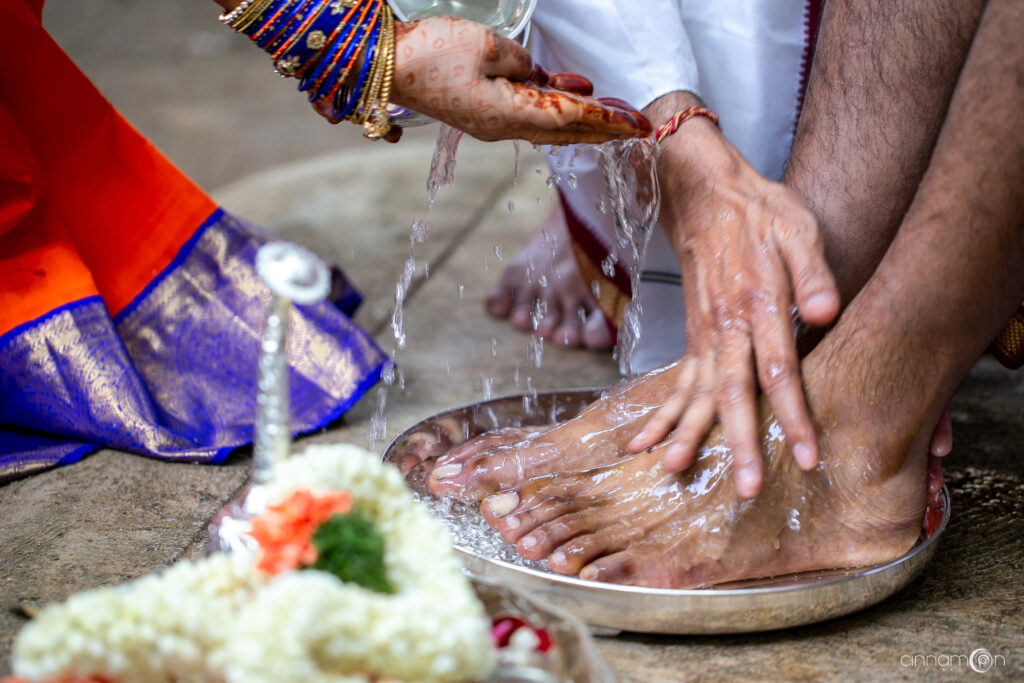
A significant formal touch is the Vara pooja. The Groom is exemplified as Lord Vishnu, who is worshiped by the bride’s party and later taken to the mandap to get his feet washed and cleansed, which is done by the Bride’s father, and the groom is presented with a new silk panche/dhoti and a scarf.
Mantapa Pooja
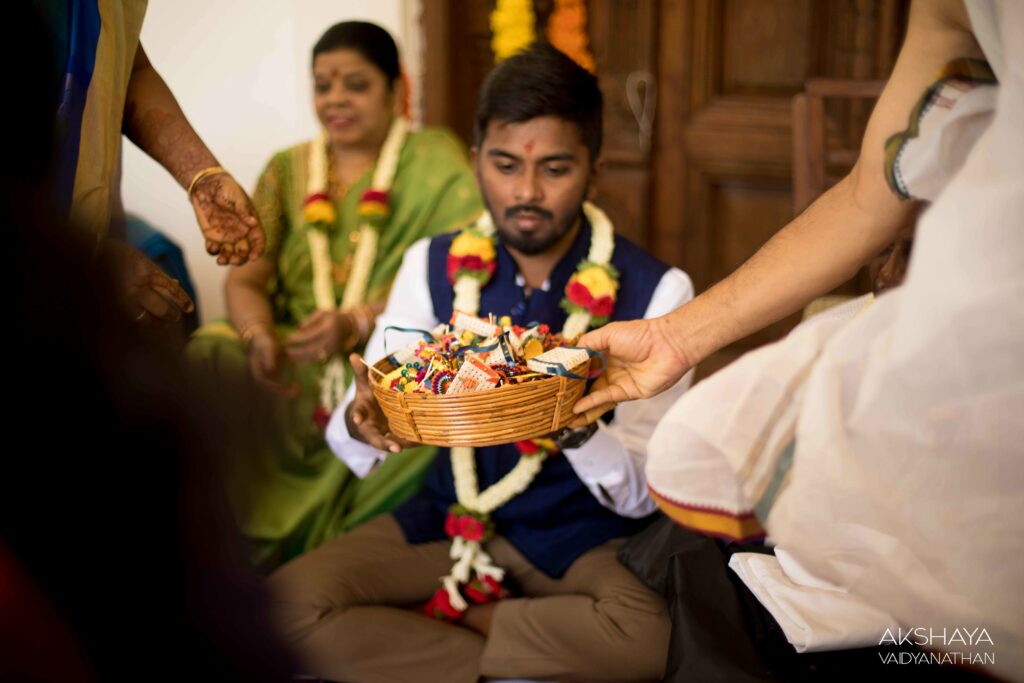
After the Deva Karya, mantapa/mandap pooja is performed—a pooja for the structure under which the main ceremonies will be performed, as a cleanser to make sure it is purified before any ceremonies are performed under it. The mandap stands on four pillars, adorned with flowers and decorations of the bride’s choice. The pillars of the mandap being four in number also symbolically represent the bride and groom’s parents who have built this life for the pair.
Main day ceremonies
Greeting the groom’s party
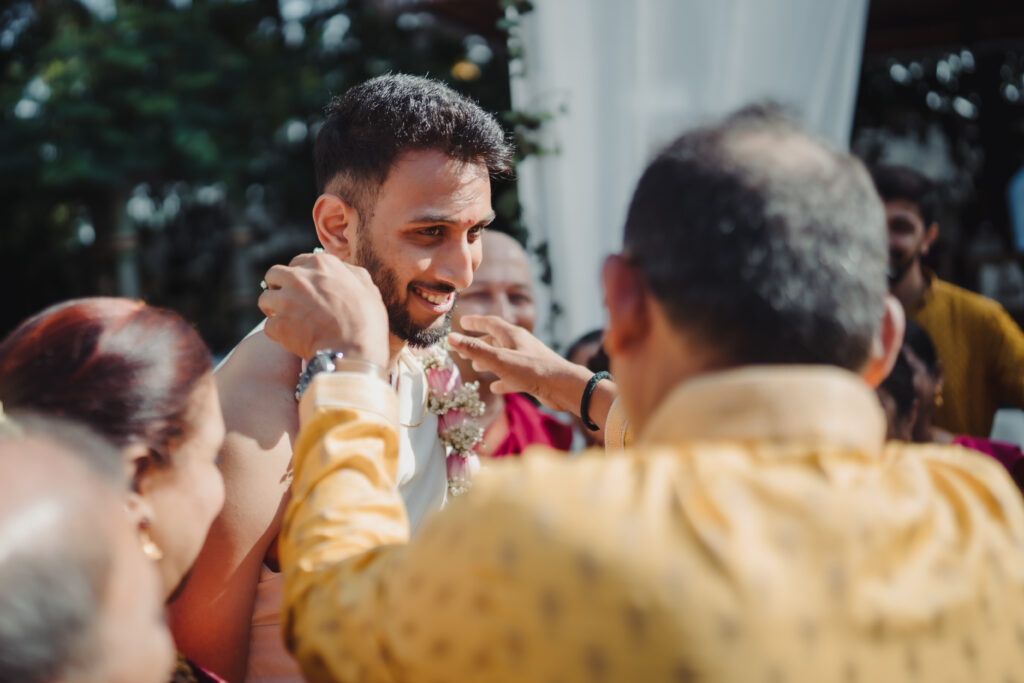
The culmination of the pre-wedding rituals gracefully paves the way for the main event—the eagerly awaited day. It commences with the welcoming of the groom’s party into the ceremonial venue, a heartwarming embrace extended by the bride’s family. This welcome generally includes ambient Indian music and flower garlands.
Gowri Pooja
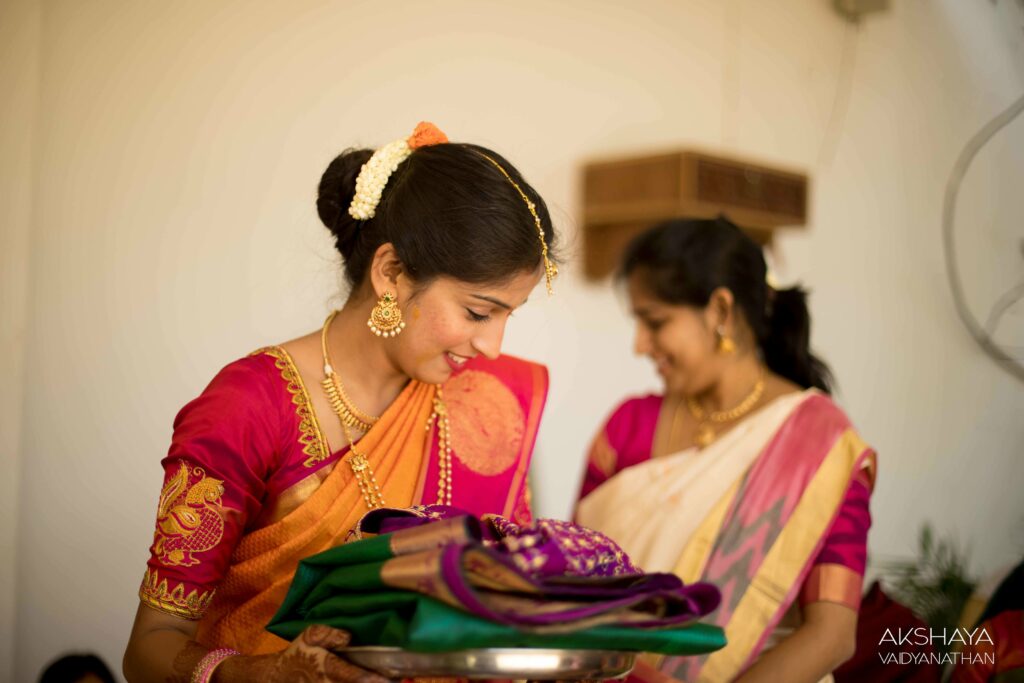
This ceremony is performed by the bride before the wedding festivities begin. There are 3 or 5 idols of Goddess Lakshmi, placed and decorated for the pooja. This ceremony is attended by the married women in the family. Gift baskets, or ‘bagna’ which consists of Navadhanya(9 kinds of grains), Vermillion and Turmeric, Bangles, and other small items that represent prosperity and fertility are placed in front of Goddess Lakshmi and then given out to 5 married women.
During this ceremony in some cultures, a thaali is tied by the mother of the bride to the bride. This is one of the two golden plates that will eventually form the gold mangalsuta that the bride will wear. In this ritual, the uncle of the bride inserts one toe ring each onto the bride’s third toe and also ties a thread with an ornament on her head, which is called Basinga.
A similar ritual is performed by the Groom and his uncle. Once the bride and groom are adorned with a Basinga and a toe ring, they are officially ready to proceed towards the mantap.
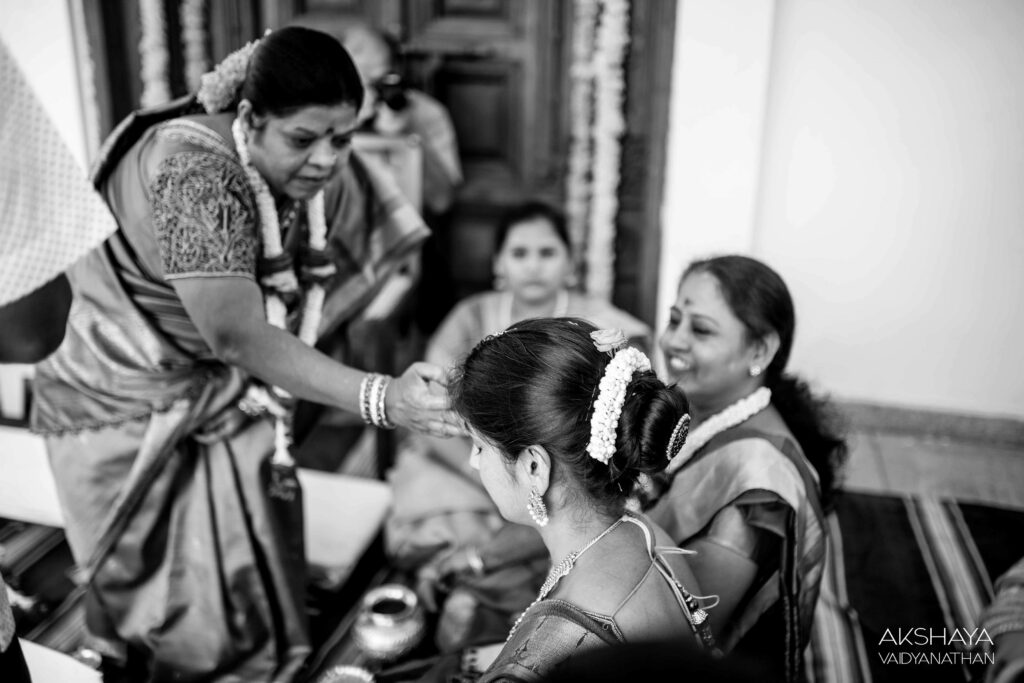
Kashi Yatra
The Kashi Yatra traditionally symbolizes a significant life transition for a man, marking his shift from the Bramacharya stage, a student’s life, to the Grihastha phase as a householder. In the Bramacharya phase, which extends until the age of 25, a young man resides and studies at a gurukul, an educational institution where students learn from their teachers. During this period, the student selects his chosen path, also known as an ashram.
The transition from the first phase to the second occurs when the man gets married to his chosen partner. This transition opens up new opportunities for the man, as he becomes responsible for earning a livelihood to meet his needs and starts indulging in personal desires. This traditional process, followed by a typical Hindu throughout his life, is often symbolically represented through a ceremonial enactment.
This enactment in which the groom takes on the role of an escapee is the Kashi Yatra. In this charming tradition, the groom playfully expresses disinterest in matrimony, embarking on a symbolic journey toward the sacred city of Kashi. Amidst this, the bride’s father intervenes to stop him from turning his back on marriage and asks him to stay, offering his daughter’s hand in marriage. The groom undergoes a transformation to dedicate his life to the married one and to protect and love his bride.
Jaimala/Varmala
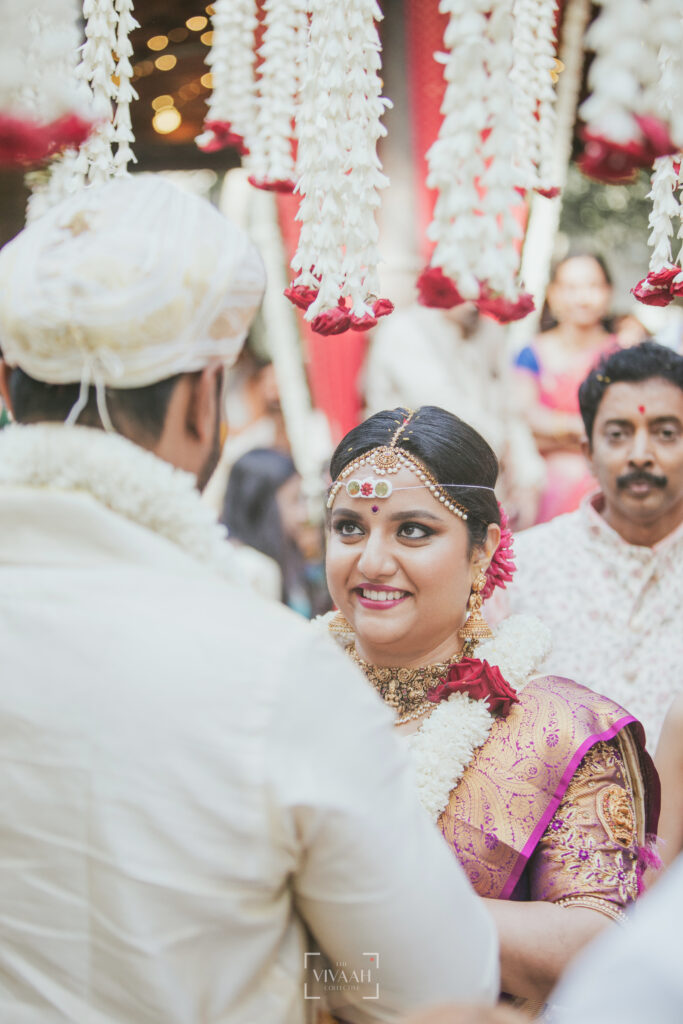
The Jaimala ceremony takes center stage. A fan adorned with peacock feathers keeps the bride’s face covered until an antarpata/cloth curtain replaces the barrier between them. This is kept to build up anticipation between the couple until the priest starts reciting mantras and the antarpata is lowered. This curiosity built between the couple finally eases to reveal nervousness and excitement. Further, they exchange Jaimalas, a garland made up of beautiful flowers, to represent a form of acceptance of each other.
Dhareherdu
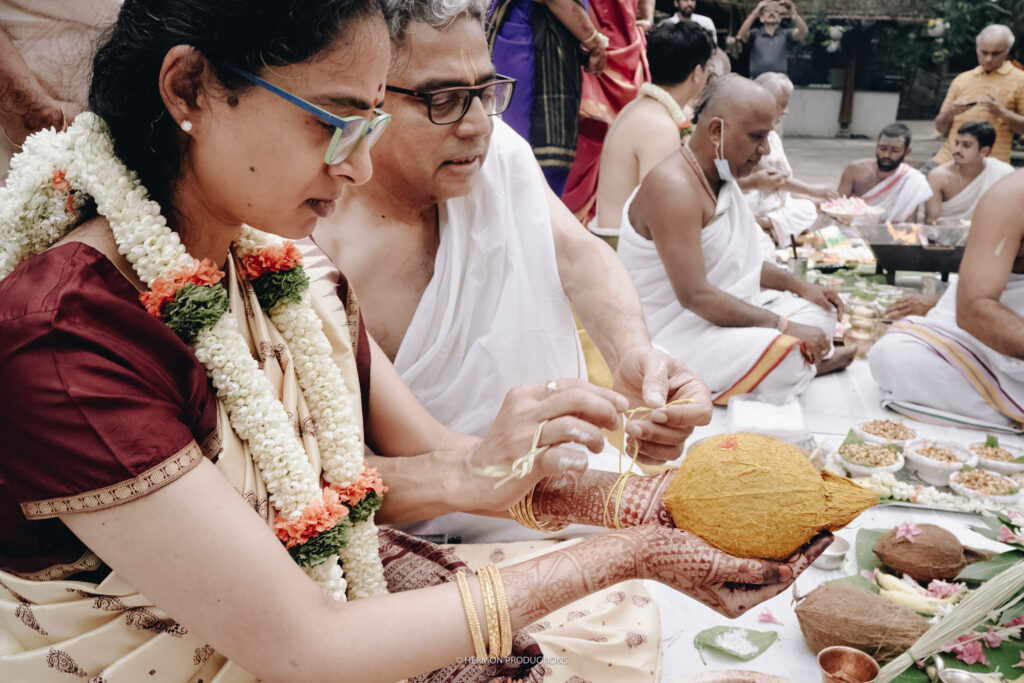
Dhareherdu, an emblem of Kannada tradition, mirrors the essence of Kanyadaan. Here, the couple’s hands are placed on top of each other, forming a bridge between two lives about to merge. A sacred coconut and betel leaf grace this unity. Holy water is poured out of a copper pot on top of this setup, blessing the couple with their well wishes for a beautiful marriage
Thaali
Just before thali ceremony is performed, the gold ornament is taken around the room to get the blessings of the audience. The thali is tied at an exact calculated moment. A thread smeared in turmeric, with black and red beads and gold ornaments hung, known as vatis, depicts the unity of the bride and groom’s families. The groom ties 3 knots and then prays to the knot for a life filled with prosperity. The Thali is placed around the bride’s neck, with the help of five married women who come together to carry out this act.
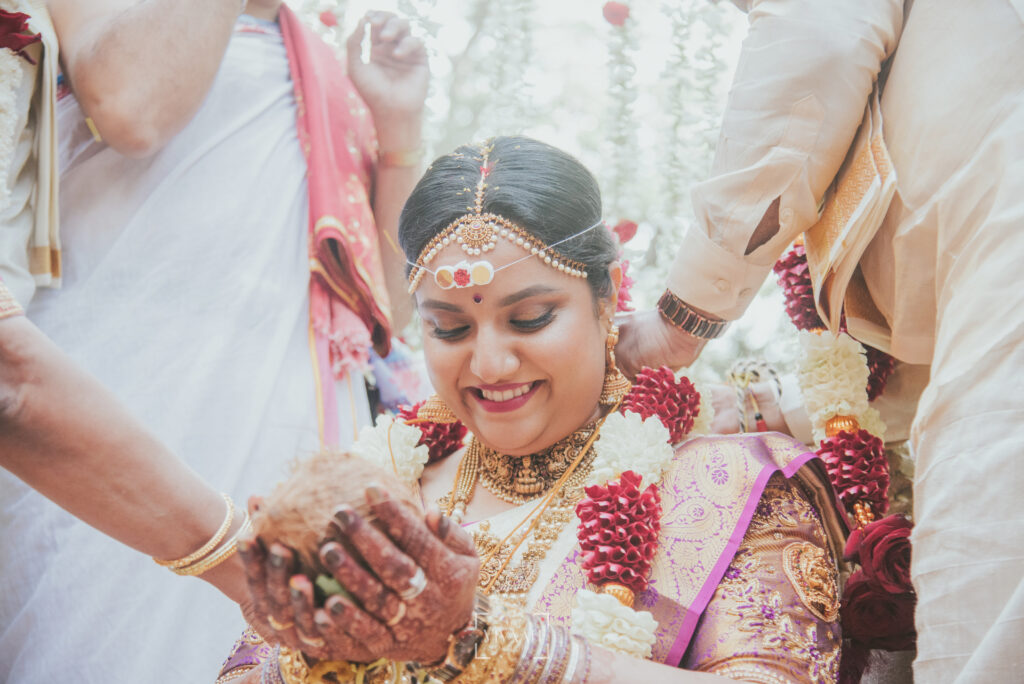
Saptapadi
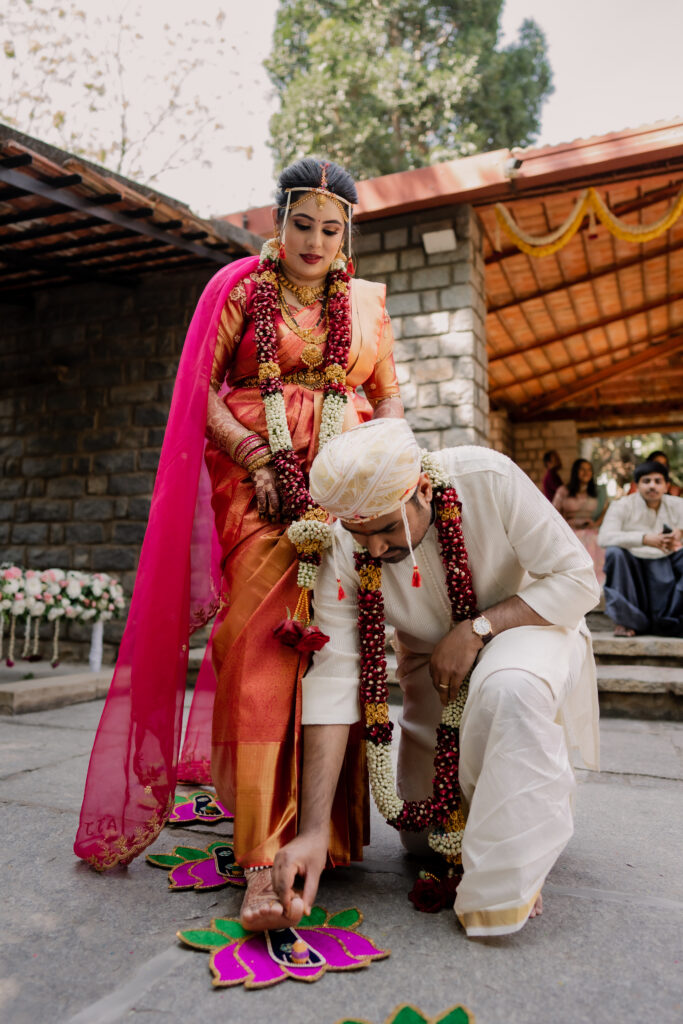
Saptapadi, more commonly the ‘7 Pheras’ in North Indian weddings is the seven steps that the bride and groom take together after the knot has been tied. This is performed with the bride’s saree being knotted with the groom’s dupatta.
Seven steps in a few customs and seven pheras taken around the homa in some, mean and promise to commit to the nourishment of the other. The couple pledges to nourish each other physically, emotionally, and spiritually, commit to staying together, and commits to embracing joy and sorrow, the couple acknowledges that life is a blend of joy, sorrow, and commitment to seeking prosperity-to work towards prosperity, responsibilities, commit to cultivating the strength of their inner selves to fortify their relationship against life’s trials, commitment to care for parents and children and lastly they commit to an eternal friendship.
On the seventh step, the groom inserts toe rings on the second toe of the bride’s feet. The toe ring is believed to be a symbol of fertility and prosperity and is hence an integral part of the wedding.
With each step and phera, the couple cements their dedication to these vows, paving the way for a harmonious, enduring marriage built on love, respect, and shared values.
Arundhati Nakshatra
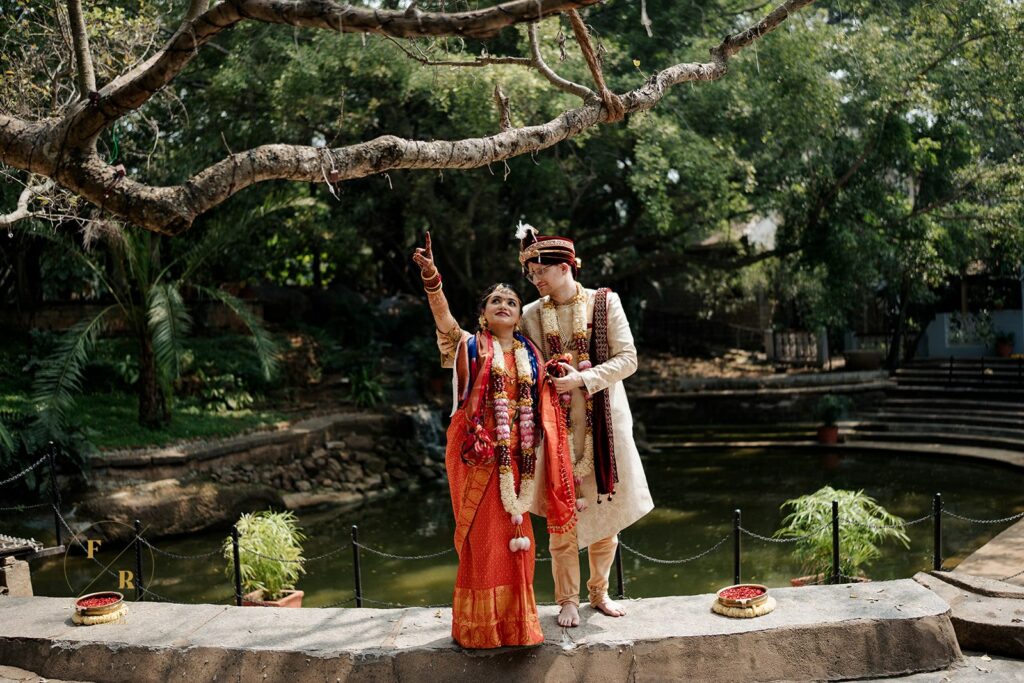
The pandit extends an invitation to the newly married couple to gaze upon the Arundhati and Vashishta nakshatra. These stars stand as an embodiment of an ideal marriage, as these twin stars revolve around each other unlike other twin stars where only one star moves around another. This union embodies harmony, devotion, and enduring love.
Post-wedding ceremonies
Laaja Homa
A homa is performed by offering puffed rice to the sacred fire after the main wedding ceremony is done and the couple is married. The significance of this is to invoke the blessings of Lord Agni and bless the couple with prosperity. The brother of the bride is involved in this ceremony to signify the linkage between the bride’s old family and the new.
Okhli
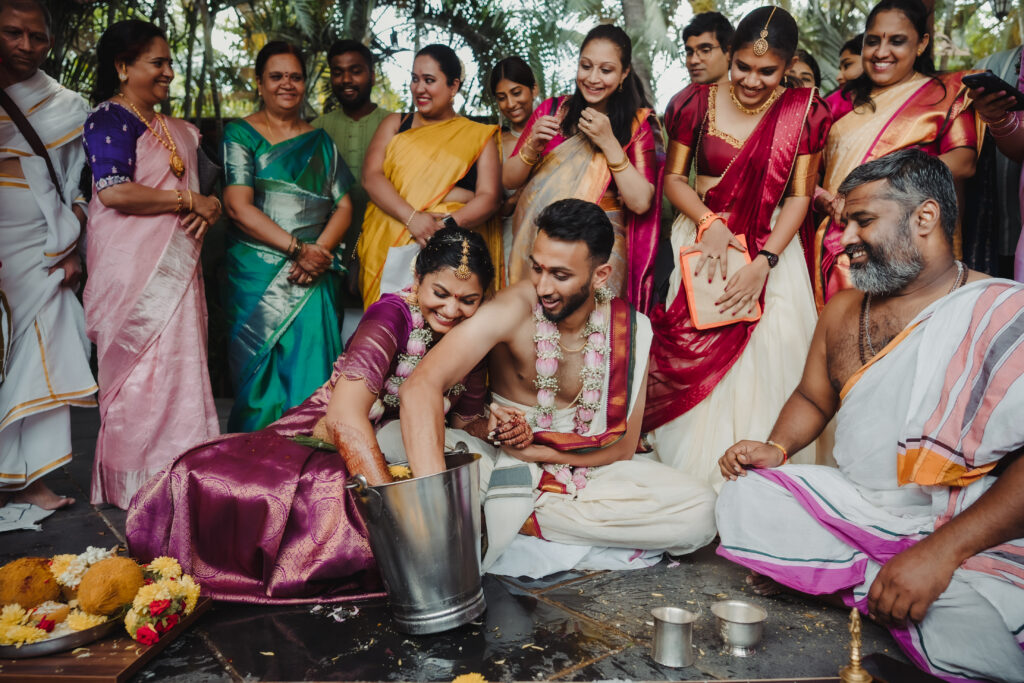
After stargazing, a delightful ceremony known as the “okhli” unfolds. With a pot of milk or vibrantly colored milk at its center, this ritual is performed to break out of the gravity amidst the ceremonies. With a playful twist, the bride and groom are entrusted with a mission—to find the golden ring.
Being able to find the ring three times will prove to be victorious in dealing with everything marriage has in store.
Vidai
Vidai, the bride, bids adieu to her family and childhood home with tears of both joy and nostalgia. Amidst the backdrop of love and support, the Vidai ceremony signifies the bride’s transition from her parental home to her new marital home. As she takes her steps forward, she embarks on a new chapter—her journey as a partner, a wife, and a companion.
Gruhapravesa
After the bride arrives at the groom’s house, Gruha Pravesha is performed, a ceremony symbolizing a house opening its doors to embrace the new bride with warmth and love. It recognizes the profound shift she’s about to embark upon—a journey from her familiar world to a new environment with roles and responsibilities that beckon her into the fold. She enters the house by ever so lightly kicking a can of rice, symbolizing that she brings prosperity into the house just like the flow of rice onto the floor when she kicks it.
In some households, the bride imprints her hand prints on the walk of the house by dipping it in turmeric water just before she enters the house. All these nuances are just a representation of her being and bringing the good fortune into her new home.
And so, in the embrace of time-honored rituals and the radiance of traditions, a Kannada wedding comes to a full circle. The blessings of Arundhati and Vashistha have guided their path, and tender moments like the Thali ceremony have sealed their bond.
As the final notes of these rituals fade into cherished memories, the essence of the Kannada wedding lingers—a testament to the unity of two families, the merging of two lives, and a sacred promise.
As we conclude our journey through the enchanting Kannada wedding rituals, we invite you to consider The Tales of Tradition Wedding Planners. With a blend of cultural reverence and contemporary elegance, we specialize in crafting weddings that tell unique love stories. Let us be your guides in creating a celebration that transcends tradition, making every moment an unforgettable tale of love. Explore the magic of tradition with a modern twist – choose The Tales of Tradition for your wedding adventure.

